#Chandrayaan-3
Text
India Moon Landing: Chandrayaan-3 Rover Captures Images from Lunar South Pole
#moon#moon landing#India#Chandrayaan-3#rover#lunar landing#South Pole#video#lunar#surface#travel#nature#science#astronomy#space#aesthetic#landscape#NASA#beauty-funny-trippy#outer space#Chandrayaan3
147 notes
·
View notes
Text

It landed perfectly!
58 notes
·
View notes
Text

Celebrating the first landing on the moon’s south pole!
23 notes
·
View notes
Text

#👏👏👏👏#India made history today at 6.04 PM IST#congratulations to isro & everyone else involved in achieving this#chandrayaan-3#isro#moon#space#desiblr#kit posts 📝
19 notes
·
View notes
Text
India has landed on the Moon!!! The landing is part of the Indian Space Research Organisation (ISRO)'s historic Chandrayaan-3 mission.
"'We have achieved soft landing on the moon,'" said ISRO Chairman Shri Somanath. 'Yes, on the moon!'"
"[Indian Prime Minister Narenda Modi] then addressed the ISRO team, speaking in Hindi but adding in English, 'India is now on the moon!'
'The success belongs to all of humanity,' he said. 'And it will help moon missions by other countries in the future. I'm confident that all countries in the world ... can all aspire for the moon and beyond. ... The sky is not the limit!'"
The remote operated lander named Vikram touched down in the south pole region at 6:02pm IST on August 23, 2023. Vikram carried a small but mighty companion, the lunar rover Pragyan (Sanskrit, "wisdom").
Vikram is named after Vikram Sarabhai, PhD, physicist, astronomer, and a major figure in the development of India's space and nuclear programs. Sarabhai served as the first chairman of the ISRO, as well as the driving force behind the organization's creation. Recognizing the need for more coordinated space research in India, Sarabhai urged the Indian government to create INCOSPAR - the committee that eventually formed the ISRO in 1969.
#india moon mission#indian space research organisation#chandrayaan3#ISRO#chandrayaan-3#vikram lander#India moon landing#pragyan rover#Vikram Sarabhai
14 notes
·
View notes
Text
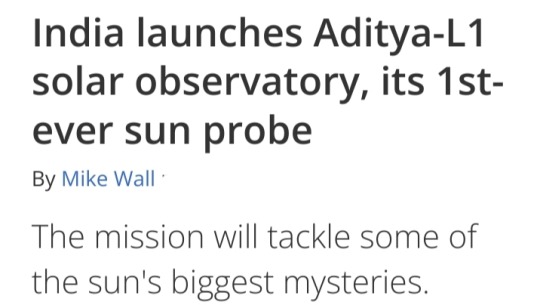
2 September 2022
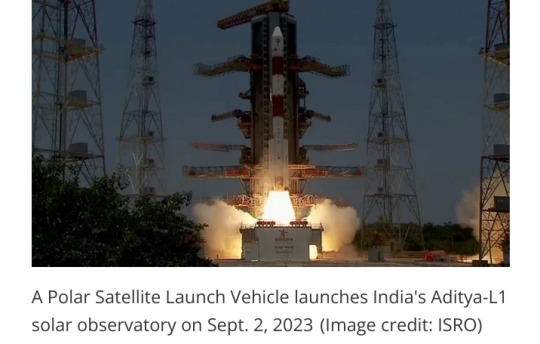
Fresh off its success at the moon, India is now headed for the sun.
The nation launched its first-ever solar observatory today (Sept. 2), sending the Aditya-L1 probe skyward atop a Polar Satellite Launch Vehicle (PSLV) from Satish Dhawan Space Centre at 2:20 a.m. EDT (0620 GMT; 11:50 a.m. local India time).
The PSLV deployed Aditya-L1 into low Earth orbit (LEO) as planned about 63 minutes after liftoff, sparking applause and high fives in mission control.
"Congratulations, India, and congratulations, ISRO [the Indian Space Research Organisation]," Jitendra Singh, India's Minister of State for Science and Technology, said shortly after deployment on ISRO's launch webcast.
"While the whole world watched this with bated breath, it is indeed a sunshine moment for India," Singh added.
The successful launch followed on the heels of another big milestone for India: On August 23, its Chandrayaan-3 mission became the first to land softly near the moon's south pole.
Chandrayaan-3's lander-rover duo are expected to conk out in a week or so, when the harsh lunar night falls at their touchdown site. But Aditya-L1's long journey has just begun.
A long road to a good sun-viewing spot
Aditya-L1 won't stay in LEO forever:
After a series of checkouts, it will use its onboard propulsion system to head toward Earth-sun Lagrange Point 1 (L1), a gravitationally stable spot about 1 million miles (1.5 million kilometers) from our planet in the direction of the sun.
That destination explains the latter part of the mission's name. And the first part is simple enough: "Aditya" translates to "sun" in Sanskrit.
The 3,260-pound (1,480 kilograms) observatory will arrive at L1 about four months from now, if all goes according to plan.
But the long trek will be worth it, according to the ISRO.
"A satellite placed in the halo orbit around the L1 point has the major advantage of continuously viewing the sun without any occultation/eclipses," ISRO officials wrote in an Aditya-L1 mission description.
"This will provide a greater advantage of observing the solar activities and its effect on space weather in real time."
Indeed, another sun-studying spacecraft is already at L1 — the Solar and Heliospheric Observatory (SOHO), a joint NASA-European Space Agency mission that launched in December 1995.
(Several other spacecraft, including NASA's James Webb Space Telescope, are at Earth-sun Lagrange Point 2, which is a million miles from Earth, in the direction away from the sun.)

Solar flares, the coronal heating mystery and more
Once it's settled in at L1, the solar probe will use four three science instruments to study the particles and magnetic fields in its immediate surroundings and four others to scrutinize the sun's surface (known as the photosphere) and its atmosphere.
This work will help scientists better understand solar activity, including the dynamics of solar flares and coronal mass ejections (CMEs), ISRO officials say.
Flares are powerful flashes of high-energy radiation, and CMEs are huge eruptions of solar plasma.
Both types of outburst can affect us here on Earth. Intense CMEs that hit our planet, for example, trigger geomagnetic storms that can disrupt satellite navigation and power grids.
(As a side benefit, such storms also supercharge the gorgeous light shows known as auroras.)
Aditya-L1 will also tackle the "coronal heating problem," one of the biggest mysteries in heliophysics.
The corona — the sun's wispy outer atmosphere — is incredibly hot, reaching temperatures around 2 million degrees Fahrenheit (1.1 million degrees Celsius), according to NASA.
That's about 200 times hotter than the solar surface, which is "only" 10,000 degrees F (5,500 degrees C) or so.
It's still unclear what is responsible for this startling and counterintuitive discrepancy.
(Why would it be hotter away from the sun's core, where the energy-producing nuclear fusion reactions are occurring?)
Aditya-L1 has other science goals as well. For instance, the mission also aims to more fully flesh out the solar wind, the stream of charged particles flowing constantly from the sun, ISRO officials said.
Aditya-L1 will measure the composition of the solar wind and attempt to determine how it is accelerated.
And Aditya-L1 will do all this work on the cheap:
The mission's price tag is about 3.8 billion rupees, or $46 million US at current exchange rates.
That's in the same ballpark as Chandrayaan-3
India's first successful moon-landing mission costs about 6.15 billion rupees, or $74 million US.
For comparison, NASA's most recent big-ticket sun mission, the record-setting Parker Solar Probe, costs roughly $1.5 billion.
This disparity should not be viewed as an indictment of NASA, however; labor costs are much higher in the United States than in India, among other differences between the two nations' economies.
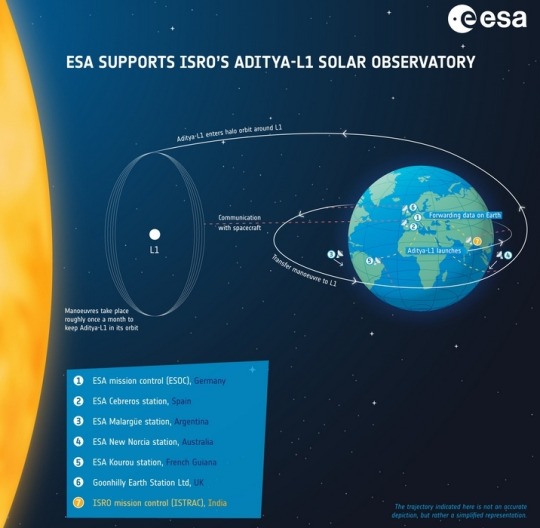
Aditya-L1 is a coronagraphy spacecraft to study the solar atmosphere, designed and developed by the Indian Space Research Organisation (ISRO) and various other Indian research institutes.
#India#Aditya-L1#Polar Satellite Launch Vehicle (PSLV)#Satish Dhawan Space Centre#low Earth orbit (LEO)#sun#Indian Space Research Organisation#Chandrayaan-3#Earth-sun Lagrange Point 1 (L1)#Solar and Heliospheric Observatory (SOHO)#solar flares#coronal mass ejections (CMEs)#coronal heating problem#heliophysics#solar wind#Parker Solar Probe#NASA#solar observatory#solar atmosphere
12 notes
·
View notes
Text
India lands robotic Chandrayaan-3 near Moon's south pole
People celebrate at the Indian Space Research Organisation’s mission control following the successful landing of the Chandrayaan-3 spacecraft. Credit: ISRO
India has successfully soft-landed a robotic spacecraft on the Moon, becoming only the fourth country to do so, and the first to touchdown at the south pole region.
Continue reading Untitled

View On WordPress
15 notes
·
View notes
Text
बधाई हो भारत! Congratulations India!
Congratulations India!!
ISRO – Indian Space Research Organisation has achieved the unprecedented soft landing of a probe on the Moon’s South Pole.
Image taken on Internet
This is a huge success for a nation that has been able to successfully send a mission to the Moon on a budget of just under $75 million (around ₹ 615 crore) to build the Chandrayaan-3. As a paragon, Russia’s Luna 25, which…
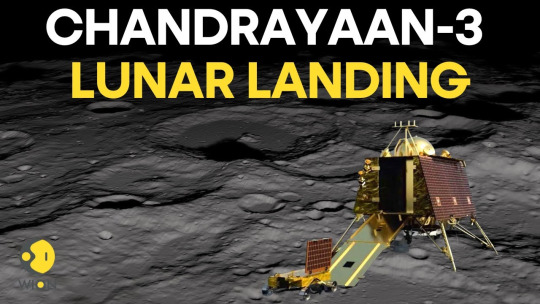
View On WordPress
#Chandrayaan-3#India#Indian Space Research Organisation#ISRO#ISRO - Indian Space Research Organisation#moon#Moon Landing#Moon South Pole#Raffaello Palandri#Space Mission
14 notes
·
View notes
Text
i'm literally getting a degree in astronomy rn why did I hear about India's lunar landing from a tumblr email
8 notes
·
View notes
Text
Congratulations to India on the Moon Landing!
So exciting for ISRO and all those that contributed to Chandrayaan-3's success. May those astronauts discover lots!
7 notes
·
View notes
Text
youtube
Congratulations to India for its perfect landing of the Chandrayaan-3 spacecraft on the surface of the moon this week! 🚀 🌓 🇮🇳
While the soft landing was well executed, it's equally significant that the landing took place in the moon's south polar region – an area which has not previously been explored.
This achievement was a contrast to Russia's Luna-25 craft crashing on the moon's surface a few days earlier. After the failure of Luna-25, a scientist who served as a consultant for the mission, Mikhail Marov, was rushed to the hospital.
Luna-25 crash: Russian scientist who worked on Putin’s failed moon mission rushed to hospital
Good luck to Mr. Marov! Over 40 business people, government officials, military officers, and dissidents associated with Russia have died under unusual circumstances since the start of 2022. And that doesn't include Yevgeny Prigozhin.
#india#chandrayaan-3#space exploration#moon#lunar landing#russia#luna-25#russia's epic fail#mikhail marov#भारत#ভারত#இந்தியா#ഇന്ത്യ#ਭਾਰਤ#चांद#মহাকাশ অনুসন্ধান#خلائی ریسرچ#चंद्रयान-3#луна-25#россия#эпический провал россии#михаил маров
4 notes
·
View notes
Text
From this

To the moon 🌙!

The first set of photos… are from 1980!
3 notes
·
View notes
Text
India becomes fourth country to land on the moon, first on the south pole, with Chandrayaan-3 spacecraft
India staked new claim as a national superpower in space, landing its Chandrayaan-3 mission safely on the moon’s unexplored south pole on Wednesday.The Chandrayaan-3 spacecraft launched last month and touch downed on the lunar surface around 8:34 a.m. ET.
The feat makes India the fourth country – after Russia, the U.S. and China – to land on the moon, and the first to land on one of the moon’s…
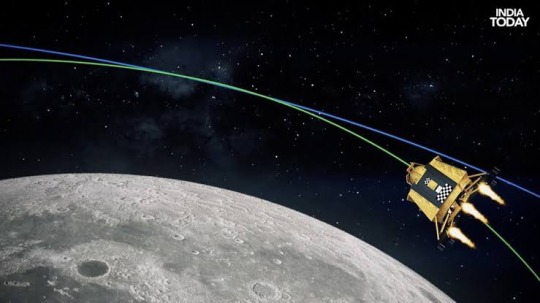
View On WordPress
3 notes
·
View notes
Text
Chandrayaan-3: ISRO delays reviving Vikram Lander and Pragyan Rover on Moon
The Indian Space Research Organisation (ISRO) had plans to wake up the Vikram lander and Pragyan rover on the moon, but they had to push it to Saturday. The Director of the Space Applications Centre, Nilesh Desai, explained that they initially wanted to activate the rover and lander on September 22, but now they are going to do it on September 23 due to some reasons.
“ISRO’s plan was to attempt…
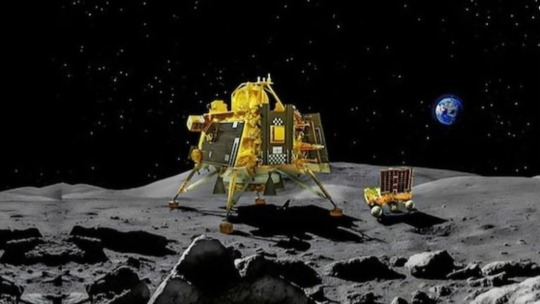
View On WordPress
2 notes
·
View notes
Text

Engineers Day is a celebration of the remarkable individuals who bridge the gap between imagination and reality.
#successstoriesofentrepreneurs#globalbusinessleadersmagazine#Entrepreneurmagazine#BestEntrepreneurMagazines#topmostbusinessindiamagazine#businessstories#bestonlinebusinessmagazine#EngineersDay#Chandrayaan-3
2 notes
·
View notes